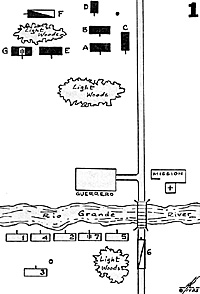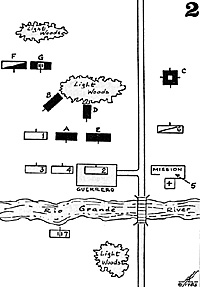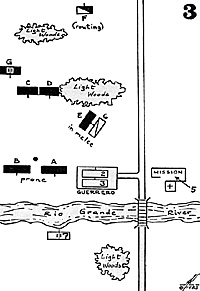This "Complete Brigadier" battle, is set in the exciting period of the Texas Revolution, and although it is fictional, it is based on actual units and conditions. (1)
The premise, is that Colonel James W. Fannin Jr. (Nick Nascati), commander of the Texian "Army" based in Coliad, has decided to take the offensive. His objective, is to intercept the advance guard of Santa Anna's army, commanded by General de Brigada Joaquin Ramieriz y Sesma (Ken Skinner), before it can set foot in Texas. (2)
| Army of the Republic of Texas | |||
|---|---|---|---|
| Unit | Type | Morale | Weapon |
| 1. Kentucky Mustangs | Irreg. | Reg. | Flintlock Musket |
| 2. Alabama Red Rovers | Irreg. | Reg. | Flintlock Musket |
| 3. Mobile Greys | Irreg. | Reg. | Flintlock Musket |
| 4. 1st New Orlean Greys | Irreg. | Reg. | Flintlock Musket |
| 5. 2nd New Orlean Greys | Irreg. | Reg. | Flintlock Musket |
| 6. Matagorda Mounted Rifles | Irreg. | Elite | Roundball Rifle |
| 7. San Patricio Irish Battery | Irreg. | Reg. | 3 X 6lb guns |
| Advance Guard of the Santanista Army | |||
| A. Jimenez Permantes | Line | Reg. | Fusil |
| B. Matamoros Permantes | Line | Reg. | Fusil |
| C. San Luis Potosi Activos | Line | Green | Fusil |
| D. Grenaderos | Line | Elite | Flintlock Musket |
| E. Cazadores | Light | Elite | Roundball Rifle |
| F. Caballeros de Dolores | Light | Reg. | Lance, Carbine |
| G. Batteria de Artilleria | Line | Reg. | 4 X 6lb guns |
THE BATTLE
 Opening dispositions were as shown in Map 1.
(3)
Opening dispositions were as shown in Map 1.
(3)
TURN #1
Fannin urged his little army forward, and the troops splashed across the shallows of the Rio Grande River into Mexico. The mounted rifles crossed at the bridge, and dashed up the road at the double. The Irish gunners, full of enthusiasm, prepared to fire a volley, when they realized that their only target was woods, and they began furiously prolonging their guns to the left.
Sesma ordered his units forward to counter the Texian advance, his light infantry moved obliquely towards the town, while the militia of San Luis Potosi advanced to meet the mounted rifles. The Lancers, in a long, impressive line, began to trot forward to threaten the Texian left flank, while the Mexican artillery quickly deplayed to open fire.
TURN #2
The Red Rovers occupied Guerrero, while the 2nd New Orleans Greys advanced towards the mission. The mounted rifles opened into a line in an attempt to engage the militia in a long range fire fight, while the Irishmen struggled to move their guns to a better position. The remaining Texian units were deploying into open order on the plain west of town.
The Santanistas continued their advance, and the Caballeros de Dolores became a serious threat to the Texian left flank. The militia facing the mounted rifles had to stand and take unanswered fire, being too far fortheir pitiful fusils to have any effect in return.
QUESTION #1 WHEN A TARGET IS FIRED ON BY A UNIT WITH LONGER RANGE WEAPONS, MUST IT HALT IMMEDIATELY, OR DOES IT ADVANCE UNTIL ITS OWN WEAPONS ARE IN RANGE? We assumed that the unit would continue to advance.
TURNS #3-5
Firefights developed along the line, with the Texians doing incredible damage to the Santanista infantry as they moved into Fusil range. The mounted rifles were having little effect on the militia, and eventually, Fannin galloped over to them, to lead them closer to the main action developing on his left and center. With the town and the mission securely in Texian hands, the left flank appeared to be the crucial sector of the battle.
The real battle started to develop, the Mexican Matamoros battalion charged the Kentucky Mustangs, who already shaken by casualties from the Mexican artiliery, ran away before the regulars could close into contact. Their line of retreat sent them crashing right into the Mobile Greys, sending them running also. The Mexicans pursued, cutting down more of the Kentuckians, and forcing them to surrender (TURN #8). The Mobile Greys in the meantime, continued to retreat towards Guerrero.
QUESTION #2. WHAT HAPPENS TO THE MORALE OF A CONFIDENT IRREGULAR UNIT FORCED TO RETREAT BY CONTACT WITH A FRIENDLY RETREATING UNIT? Going over the tables, we concluded that it would be shaken.
TURNS #7-8
 The firefight flared along the line, and casualties
mounted. The Rovers in Guerrero began to take light
casualties from the Mexican artillery, but secure in the
town, their morale remained stable. The Lancers advanced
up to the Mexican line, and were poised to strike the 1st
New Orleans Greys.
The firefight flared along the line, and casualties
mounted. The Rovers in Guerrero began to take light
casualties from the Mexican artillery, but secure in the
town, their morale remained stable. The Lancers advanced
up to the Mexican line, and were poised to strike the 1st
New Orleans Greys.
TURN #9
The Mobile Greys got into Guerrero in the nick of time, as the Lancers crashed into the 1st New Orleans Greys, driving them to the edge of the town, and forcing them to surrender.
QUESTION #3 WHAT HAPPENS WHEN A RETREATING UNIT IS PURSUED AND THEIR SPEED WILL TAKE THEM INTO A TOWN? DO THEY STOP OR CONTINUE, AND DO THE PURSUERS FOLLOW THEM INTO THE STREETS? We assumed that they would stop at the edge of the town, as in this situation, the town was already occupied.
QUESTION #6 THIS BEING THE 12th AND LAST TURN, THE MELEE HAD TO REMAIN UNRESOLVED. IS THIS CORRECT, OR SHOULD AN EXTRA ROUND OF MELEE BE INSERTED TO RESOLVE THE ACTION?
However, the time spent by the Lancers in mopping up the surrendering Greys, left them in a very unpleasant situation, trapped between the muskets of the Red Rovers, and the guns of the Irish battery, elated to finally have a real target.
TURN #10
The Lancers ceased to exist, as a blast of canister and a volley of close range musketry eliminated 88% of the unit, and sent the remainder running for home.(4) The rearguard Mexican unit now advanced towards Guerrero, as the forward units, tired of being cut down by the accurate fire of the Texian artillery on turn 9, went prone. The Mobile Greys, now safely in the town, rallied and returned to their confident status.
QUESTION #4 WHAT SHOULD THE FIELD OF FIRE FOR TROOPS IN A TOWN BE? The rules seem to indicate a 360 degree field of fire at full strength, and a conversation with Peter Quinlan of Adventure Games confirmed this interpretation.
QUESTION #5 CAN PRONE UNITS BE FIRED OVER BY FRIENDS OR ENEMIES?
TURN #11
 The Mexican advance continued, as they tried to
move in to closer range where the better weapons of the
elite troops could do more damage. The confident Texians
stood their ground, cooly letting off volley after volley.
The Mexican advance continued, as they tried to
move in to closer range where the better weapons of the
elite troops could do more damage. The confident Texians
stood their ground, cooly letting off volley after volley.
TURN #12
The mounted rifles could stand their inactivity no longer, and launched a pell mell charge into the Cazadores, who had been skirmishing with the Red Rovers since turn 3. One last volley of musketry all around, and it was time to determine the victor.
THE RESULTS
After removing their 24 figure handicap (see note #2), it was discovered that the Texians had only won by a narrow margin. 62 Texians / 54 Mexicans = 1.14 margin of victoryDesigner's replies to Questions in THE BATTLE OF GUERRERO
ANSWER #1: Taking fire does not in itself require a unit to halt. A unit with move orders continues to advance until its morale fails or it contacts an enemy unit. If a morale check results in shaken, the unit cannot advance and will probably get into a firefight. If a check results in broken or routed morale the unit must retreat at the double. If a move order results in a contact, without a charge order, the situation is an encounter (Rules 115, 116) and will probably be a firefight. A contact with a charge order may result, morale permitting, in a melee situation.
ANSWER #2: The rule (Appendix G, p. 76, Rule 106) requiring an irregular unit to retreat when a friendly unit retreats through it, does not mention the morale of the irregular unit. The players' deduction from the tables makes sense. The irregular's morale should be affected. Shaken is the least damaging of the three morale levels associated with retreats.
ANSWER #3: In this case the type of building area represented by the town of Guerrero seems to be the significant point. Volume 1, page 41 of TCB defines dense and open building areas. Dense areas are towns, villages, walled farms, manors and monasteries in which the buildings are densely or closely packed together, connected by high walls and gates, and crossed by narrow alleys or passages suited for toot or horseback traffic. I think a Mexican village of stone or adobe would qualify as a dense building area. It makes sense that the retreating force would find it as difficult to get inside in a hurry as the attacking force would. I agree with the players' decision. The Greys were caught outside of town by the cavalry pursuit (Table 5, Loser's Results, lose one for every two or four victors pursuing.
Had the Greys escaped into a building area, the cavalry would not have been able to follow them (Rule 103).
ANSWER #4: My house rule for the field of fire from a building area is that one stand of figures can fire from each one space-length of the side facing the target, allowing fire at targets across an 180 degree arc from that side. If the building area were attacked from two or more directions, the defending fire result would have to be divided between the number of directions, in the same ratio as the compared length of the sides in question.
ANSWER #5: As described in rule 125, Artillery shot and small arms at close range can be fired over friendly units provided that the friendly unit is at least one contour /eve/ lower than either the firing unit or the target unit and that the friendly unit is closer to the firing unit than to the target unit. This rule does not exclude units lying down; it means friendly units regardless of whether they are standing or lying.
ANSWER #6: When the last turn of a game has units in melee, which technically would be resolved in the next turn, I prefer to resolve them before settling the victory conditions. The melee itself will result in one side being shaken, broken or routed, thus excluding that unit from victory conditions. The TCB sequence seperates the charge, during the movement phase of one turn, from its resolution, during the melee phase at the beginning of the next turn. The seperation makes sense mechanically, in order to have all units, whether retreating, marching or charging, all move during the same phase. But it also separates the cause and the effect, if the melee is not resolved, which is not intended. End the game after resolving the melees, without further movement, pursuit or fire.
THE CONCLUSIONS
The game played in a little over three hours, including set up time, and time taken during the game for photos. The period itself offers a wide range of possibilities in the years 1836-1848, from the pitched battles of the Mexican- American War, to Indian fighting and amphibious operations. The "Complete Brigadier" rules, seem to us to be perfect for this period, due to both the scale and the adjustable game system.
Although, as can be seen throughout the narrative, some questions did arise during the battle (one of some half-dozen we have played), the general feel of the rules seems correct tactically, and more importantly, is a lot of fun.
NOTES
1. Although misleading in its details, since the "Complete Brigadier" article in the Courier (vol. IV, no. 4), gives a good overall breakdown of the rules system, we won't repeat it here.
2. The Texian force is without bayonets. The battery is from the Irish settlement of San Patricio, Texas, and should not be confused with the San Patricios of the Mexican -American War. The Texians had an additional handicap in that after the initial order writing, Fannin had to be in direct contact with the units to give orders.
The fusils of the Mexicans were used to simulate their historically bad musketry and fire discipline as only the elite troops had better weapons.
Both forces totaled 796 points, with the Texian force having an additional 24 figures, which as noted before, were removed before determining the winner/loser ratio. Figures used were 15mm Miniature Figurines ACW and Napoleonics, painted to represent the proper units. The game was played on a 4.5 X 5 ft. table.
3. For this game, we used a screen across the center of the table, to hide our initial deployments. This proved quite interesting, as it resulted in the unfortunate placement of the Irish battery at the start of the game.
4. The Lancers' devastating losses were calculated as follows: From the Red Rovers;
- a. 21 figures divided by a factor of 7 = 3
b. + 50% for firing from a rest = 4.5
c. target in column, double effect = 9
d. target mounted, add 50% = 13.5
From Artillery Canister;
- a. 18 gunners divided by a factor of 7 = 2.6
b. target in column, double effect = 5.2
c. target mounted, add 50% = 7.8
Total 13.5 + 7.8 = 21.3 Or 21 figures
Back to Table of Contents -- Courier Vol. V #4
To Courier List of Issues
To MagWeb Master Magazine List
© Copyright 1984 by The Courier Publishing Company.
This article appears in MagWeb (Magazine Web) on the Internet World Wide Web.
Other military history articles and gaming articles are available at http://www.magweb.com